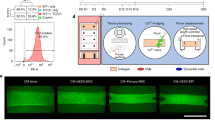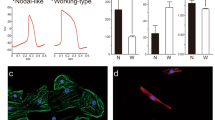Abstract
Cell therapy is emerging as a promising strategy for myocardial repair. This approach is hampered, however, by the lack of sources for human cardiac tissue and by the absence of direct evidence for functional integration of donor cells into host tissues. Here we investigate whether cells derived from human embryonic stem (hES) cells can restore myocardial electromechanical properties. Cardiomyocyte cell grafts were generated from hES cells in vitro using the embryoid body differentiating system. This tissue formed structural and electromechanical connections with cultured rat cardiomyocytes. In vivo integration was shown in a large-animal model of slow heart rate. The transplanted hES cell–derived cardiomyocytes paced the hearts of swine with complete atrioventricular block, as assessed by detailed three-dimensional electrophysiological mapping and histopathological examination. These results demonstrate the potential of hES-cell cardiomyocytes to act as a rate-responsive biological pacemaker and for future myocardial regeneration strategies.
This is a preview of subscription content, access via your institution
Access options
Subscribe to this journal
Receive 12 print issues and online access
$209.00 per year
only $17.42 per issue
Buy this article
- Purchase on Springer Link
- Instant access to full article PDF
Prices may be subject to local taxes which are calculated during checkout






Similar content being viewed by others
References
Pasumarthi, K.B. & Field, L.J. Cardiomyocyte cell cycle regulation. Circ. Res. 90, 1044–1054 (2002).
Cohn, J.N. et al. Report of the National Heart, Lung, and Blood Institute Special Emphasis Panel on Heart Failure Research. Circulation 95, 766–770 (1997).
Kusumoto, F.M. & Goldschlager, N. Cardiac pacing. N. Engl. J. Med. 334, 89–97 (1996).
Taylor, D.A. et al. Regenerating functional myocardium: improved performance after skeletal myoblast transplantation. Nat. Med. 4, 929–933 (1998).
Murry, C.E., Wiseman, R.W., Schwartz, S.M. & Hauschka, S.D. Skeletal myoblast transplantation for repair of myocardial necrosis. J. Clin. Invest. 98, 2512–2523 (1996).
Menasche, P. et al. Autologous skeletal myoblast transplantation for severe postinfarction left ventricular dysfunction. J. Am. Coll. Cardiol. 41, 1078–1083 (2003).
Muller-Ehmsen, J. et al. Rebuilding a damaged heart: long-term survival of transplanted neonatal rat cardiomyocytes after myocardial infarction and effect on cardiac function. Circulation 105, 1720–1726 (2002).
Reinecke, H., Zhang, M., Bartosek, T. & Murry, C.E. Survival, integration, and differentiation of cardiomyocyte grafts: a study in normal and injured rat hearts. Circulation 100, 193–202 (1999).
Soonpaa, M.H., Koh, G.Y., Klug, M.G. & Field, L.J. Formation of nascent intercalated disks between grafted fetal cardiomyocytes and host myocardium. Science 264, 98–101 (1994).
Leor, J., Patterson, M., Quinones, M.J., Kedes, L.H. & Kloner, R.A. Transplantation of fetal myocardial tissue into the infarcted myocardium of rat. A potential method for repair of infarcted myocardium? Circulation 94, II332–336 (1996).
Toma, C., Pittenger, M.F., Cahill, K.S., Byrne, B.J. & Kessler, P.D. Human mesenchymal stem cells differentiate to a cardiomyocyte phenotype in the adult murine heart. Circulation 105, 93–98 (2002).
Orlic, D. et al. Bone marrow cells regenerate infarcted myocardium. Nature 410, 701–705 (2001).
Klug, M.G., Soonpaa, M.H., Koh, G.Y. & Field, L.J. Genetically selected cardiomyocytes from differentiating embryonic stem cells form stable intracardiac grafts. J. Clin. Invest. 98, 216–224 (1996).
Rubart, M. et al. Physiological coupling of donor and host cardiomyocytes after cellular transplantation. Circ. Res. 92, 1217–1224 (2003).
Thomson, J.A. et al. Embryonic stem cell lines derived from human blastocysts. Science 282, 1145–1147 (1998).
Reubinoff, B.E., Pera, M.F., Fong, C.Y., Trounson, A. & Bongso, A. Embryonic stem cell lines from human blastocysts: somatic differentiation in vitro. Nat. Biotechnol. 18, 399–404 (2000).
Itskovitz-Eldor, J. et al. Differentiation of human embryonic stem cells into embryoid bodies compromising the three embryonic germ layers. Mol. Med. 6, 88–95 (2000).
Kehat, I. et al. Human embryonic stem cells can differentiate into myocytes with structural and functional properties of cardiomyocytes. J. Clin. Invest. 108, 407–414 (2001).
Gepstein, L. Derivation and potential applications of human embryonic stem cells. Circ. Res. 91, 866–876 (2002).
Xu, C., Police, S., Rao, N. & Carpenter, M.K. Characterization and enrichment of cardiomyocytes derived from human embryonic stem cells. Circ. Res. 91, 501–508 (2002).
Mummery, C. et al. Differentiation of human embryonic stem cells to cardiomyocytes: role of coculture with visceral endoderm-like cells. Circulation 107, 2733–2740 (2003).
Kehat, I., Gepstein, A., Spira, A., Itskovitz-Eldor, J. & Gepstein, L. High-resolution electrophysiological assessment of human embryonic stem cell-derived cardiomyocytes: a novel in vitro model for the study of conduction. Circ. Res. 91, 659–661 (2002).
Alcolea, S. et al. Downregulation of connexin 45 gene products during mouse heart development. Circ. Res. 84, 1365–1379 (1999).
Satin, J. et al. Mechanism of spontaneous excitability in human embryonic stem cell derived cardiomyocytes. J. Physiol. (2004).
Feld, Y. et al. Electrophysiological modulation of cardiomyocytic tissue by transfected fibroblasts expressing potassium channels: a novel strategy to manipulate excitability. Circulation 105, 522–529 (2002).
Ben-Haim, S.A. et al. Nonfluoroscopic, in vivo navigation and mapping technology. Nat. Med. 2, 1393–1395 (1996).
Gepstein, L., Hayam, G. & Ben-Haim, S.A. A novel method for nonfluoroscopic catheter-based electroanatomical mapping of the heart. In vitro and in vivo accuracy results. Circulation 95, 1611–1622 (1997).
Reinlib, L. & Field, L. Cell transplantation as future therapy for cardiovascular disease?: A workshop of the National Heart, Lung, and Blood Institute. Circulation 101, E182–187 (2000).
Etzion, S. et al. Influence of embryonic cardiomyocyte transplantation on the progression of heart failure in a rat model of extensive myocardial infarction. J. Mol. Cell. Cardiol. 33, 1321–1330 (2001).
Li, R.K. et al. Natural history of fetal rat cardiomyocytes transplanted into adult rat myocardial scar tissue. Circulation 96, II 179–186, discussion 177–186 (1997).
Scorsin, M. et al. Does transplantation of cardiomyocytes improve function of infarcted myocardium? Circulation 96, II–188–193 (1997).
Menasche, P. et al. Myoblast transplantation for heart failure. Lancet 357, 279–280 (2001).
Reinecke, H., MacDonald, G.H., Hauschka, S.D. & Murry, C.E. Electromechanical coupling between skeletal and cardiac muscle. Implications for infarct repair. J. Cell. Biol. 149, 731–740 (2000).
Edelberg, J.M., Aird, W.C. & Rosenberg, R.D. Enhancement of murine cardiac chronotropy by the molecular transfer of the human beta2 adrenergic receptor cDNA. J. Clin. Invest. 101, 337–343 (1998).
Miake, J., Marban, E. & Nuss, H.B. Biological pacemaker created by gene transfer. Nature 419, 132–133 (2002).
Qu, J. et al. Expression and function of a biological pacemaker in canine heart. Circulation 107, 1106–1109 (2003).
Potapova, I. et al. Human mesenchymal stem cells as a gene delivery system to create cardiac pacemakers. Circ. Res. 94, 952–959 (2004).
Amit, M. et al. Clonally derived human embryonic stem cell lines maintain pluripotency and proliferative potential for prolonged periods of culture. Dev. Biol. 227, 271–278 (2000).
Acknowledgements
We thank Asaf Zaretzki and Edith Cohen for their valuable help in the animal studies. We thank Ofer Shenker and the interdisciplinary unit for their technical assistance. This research was supported in part by the Israel Science Foundation (grant no. 520/01), by the Israel Health Ministry, by the Johnson & Johnson Focused Research Grant and by the Nahum Guzik Research Fund.
Author information
Authors and Affiliations
Corresponding author
Ethics declarations
Competing interests
The authors declare no competing financial interests.
Supplementary information
Supplementary Movie
A movie showing a typical coculture grown on top of the MEA plate. The image is shown at a high magnification ('40). Note the synchronous contractions of the hES cell–derived cardiomyocyte tissue (cell cluster on the right side of the image) and the neonatal rat ventricular myocyte monolayer. (MOV 314 kb)
Rights and permissions
About this article
Cite this article
Kehat, I., Khimovich, L., Caspi, O. et al. Electromechanical integration of cardiomyocytes derived from human embryonic stem cells. Nat Biotechnol 22, 1282–1289 (2004). https://doi.org/10.1038/nbt1014
Received:
Accepted:
Published:
Issue Date:
DOI: https://doi.org/10.1038/nbt1014
This article is cited by
-
Enhancement of pacing function by HCN4 overexpression in human pluripotent stem cell-derived cardiomyocytes
Stem Cell Research & Therapy (2022)
-
Optical mapping of human embryonic stem cell-derived cardiomyocyte graft electrical activity in injured hearts
Stem Cell Research & Therapy (2020)
-
Mending a broken heart: current strategies and limitations of cell-based therapy
Stem Cell Research & Therapy (2020)



